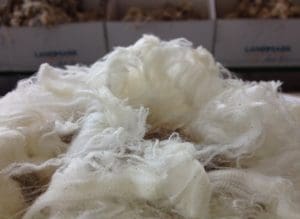 A SHORTAGE of medium Merino wool helped lift 19-23 micron fleece prices this week.
A SHORTAGE of medium Merino wool helped lift 19-23 micron fleece prices this week.
Australian Wool Exchange senior market analyst Lionel Plunkett said the AWEX Eastern Market Indicator lifted 10 cents this week, almost exclusively due to price gains in the fine and medium Merino fleece sector to close at 2021c/kg clean.
The continuing drought across most of Australia’s wool growing regions is causing a shortage of 19-22 micron wools, as the dry conditions play havoc on normal fibre diameter production, Australian Wool Innovation’s weekly market report said.
AWI said despite the EMI level increasing in $A terms this week, the tone at auction was more subdued and cautious.
“Some price relief was afforded to overseas buyers on a week-to-week forex (foreign exchange) comparison.
“All three exchange rates relative to the $A went 1.3 percent or more in their favour.”
AWEX said the EMI in $US closed 10 cents lower at US1528c/kg. Brokers passed in 3.4 percent of the 28,029 bale offering, 1087 fewer bales than last week.
Mr Plunkett said the 18.5 micron and finer wools suffered falls of 5-30 cents, as main buyer interest was focussed on the broader section of the offering.
“The largest increase in price was felt in the 19.5 to 22.5 micron range, which rose by 10 to 40 cents.”
He said the individual Micron Price Guides in all three centres – Sydney, Melbourne and Fremantle — for 20-22 micron wool have pushed further into record territory.
“Due to the fact that the coarser microns recorded the largest gains, the price differentials have constricted.
“By the end of the sale the there was only 5 cents separating the price of 19.5 to 21.5 micron,” he said.
“In some instances, selected coarser microns were bring more money than similar wool with a finer micron.”
Mr Plunkett said the skirting sector followed a similar path to the fleece, with prices for 19 micron and finer lines retracting, generally by 20 to 40 cents. Lots carrying more than 4pc vegetable matter were most affected. The 19.5 micron skirtings posted rises of generally 10-20 cents.
“A very limited selection of oddments attracted strong demand, pushing prices slightly higher for the sale, generally 5 to 10 cents.
“This was reflected in the three carding indicators rising by an average of 4 cents for the week,” he said.
More Chinese top maker demand this week
AWI said demand from top makers was more noticeable this week, and in particular from one of the larger manufacturers ex-China.
“Their involvement increased exponentially as the week progressed and they became keener as prices at the super fine (18.5 and finer) end drifted ever more closer to their broader counterparts. “Other orders for top making were evident as well through the smaller indent operators, and these orders also appeared to concentrate on areas away from the pressure point of 19.5 and 21 micron types,” AWI said.
“The larger indent operator though was firmly focussed on both of those types and with the smaller offering and selection, it was somewhat inevitable the price went up as forward sellers and other origins had to meet their obligations and fight for quantity.”
With the Fremantle auction rooms having another recess next week, the national offering will reduce next week. There are 21,326 bales listed in the year’s smaller offering, in Sydney and Melbourne next week. AWI said no radical change to current market conditions is expected.
Sources: AWEX, AWI.

HAVE YOUR SAY